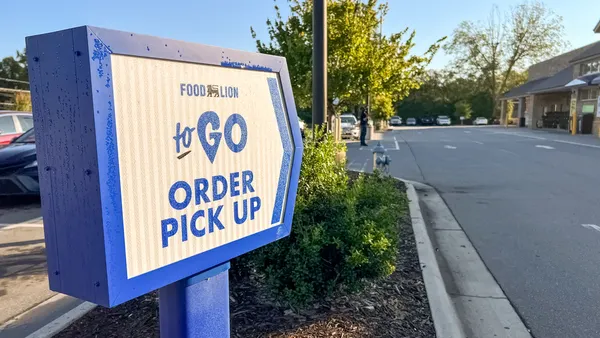Dive Brief:
- Aldi CEO Jason Hart told Business Insider the retailer plans to test curbside pickup and expand home delivery to all of its U.S. stores. He declined to provide a timeline for the expansion.
- The discount grocer currently offers home delivery through Instacart in select cities, including Atlanta and Chicago. Hart said Aldi is pleased with the partnership, and plans to continue using the e-commerce provider as it expands ordering and delivery nationwide.
- The retailer will pilot a curbside pickup program that will let shoppers order groceries online and then have them delivered to their car once they arrive at the store. The move comes on the heels of Amazon's announcement that it will offer store pickup within 30 minutes from Whole Foods locations in two cities.
Dive Insight:
Given its recent focus on growing and remodeling stores, Aldi has been slow to adopt online shopping, offering home delivery in just a few markets through Instacart. However, mounting competition and accelerating consumer demand have no doubt pushed the discounter to hasten its e-commerce rollout.
The news comes amid a flurry of activity from the likes of Kroger and Walmart, and just a few days after Amazon announced 30-minute grocery pickup at Whole Foods. Walmart plans to offer grocery delivery at 800 of its stores by the end of 2018, and it currently offers curbside pickup at more than 1,500 locations. Kroger also is delivering groceries to almost 900 of its stores and plans to add its ClickList curbside pickup service this year to an additional 500 stores. It currently offers the service at 1,100 locations. The grocer estimates that 75% of households in Kroger markets can either shop online through curbside pickup or delivery, with a goal of expanding that threshold to nearly 100% by the end of 2018.
As these services become standard at more supermarkets, Aldi is forced to join in or potentially lose customers to grocers that offer it. With e-commerce sales expected to reach $100 billion by 2022, chains can't afford to lose out.
"E-commerce is the platform to be in," Carmela Cugini, vice president of grocery, wholesale and international at Walmart's Jet.com, said at the Digital Food and Beverage conference last month in Chicago. "The retail landscape will always have brick and mortar. That is not going away, but (e-commerce) is reshaping what the future looks like."
If Aldi has ambitions to be the third largest grocer by store count by 2022, then it has to keep up with industry trends and consumer demands. It already has expanded its produce offerings, and this week announced plans to increase its assortment of new products by 20%. Aldi also announced last year that it will spend $3 billion during the next five years to add 900 new stores and $2 billion to remodel current ones.
Once viewed as old and outdated, Aldi has become a headache for traditional retailers and specialty players alike. Even though it isn't dominant in most of the markets it serves, it is slowly grabbing market share in places like California and the mid-Atlantic region while simultaneously pushing into new markets like Arizona, with plans to deploy new stores in highly competitive areas. Aldi has forced competitors like Walmart to take notice. It's unlikely the curbside and home delivery services will give Aldi a major advantage, but it should help solidify customer loyalty as the chain continues its ambitious growth campaign.













